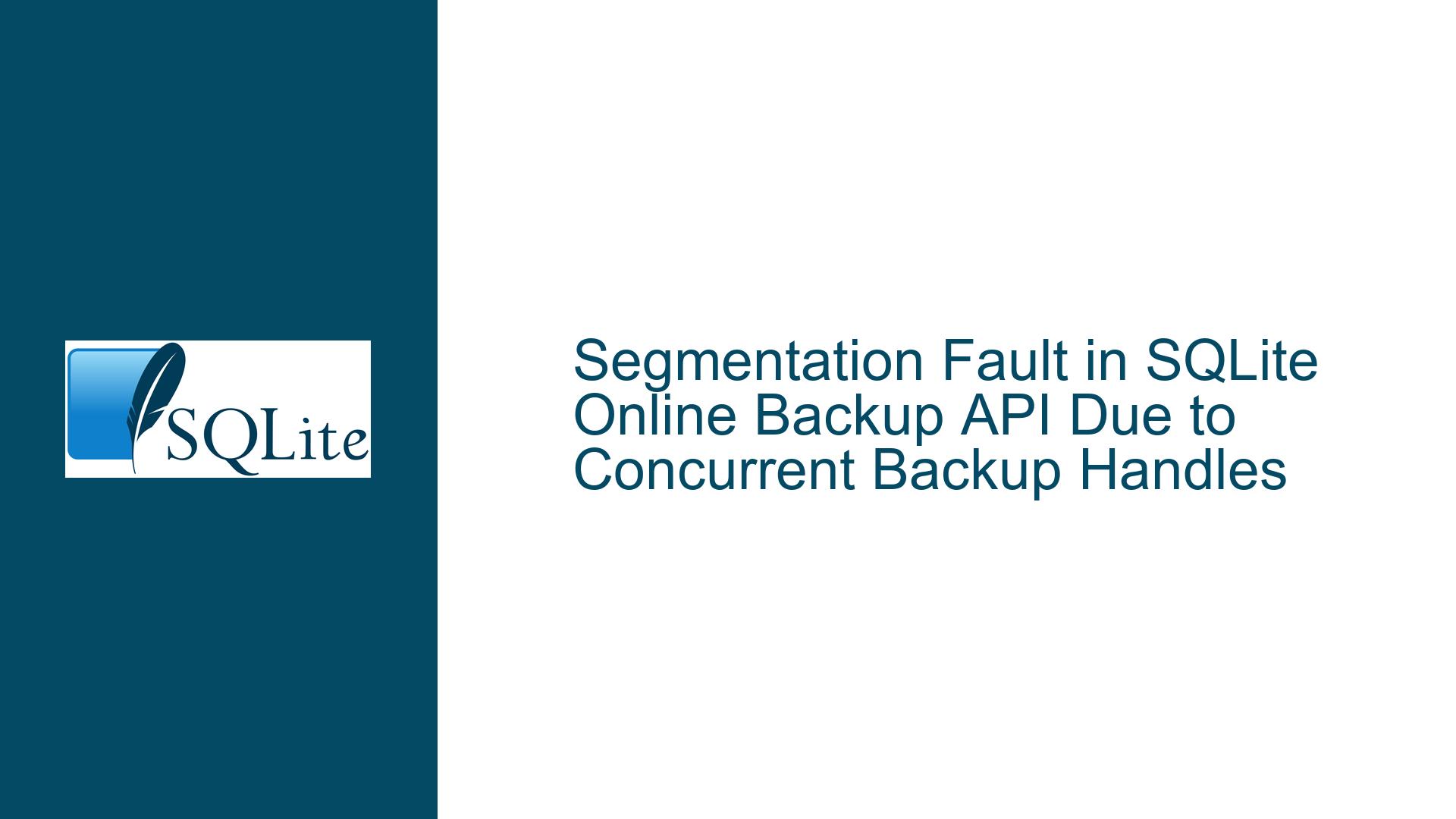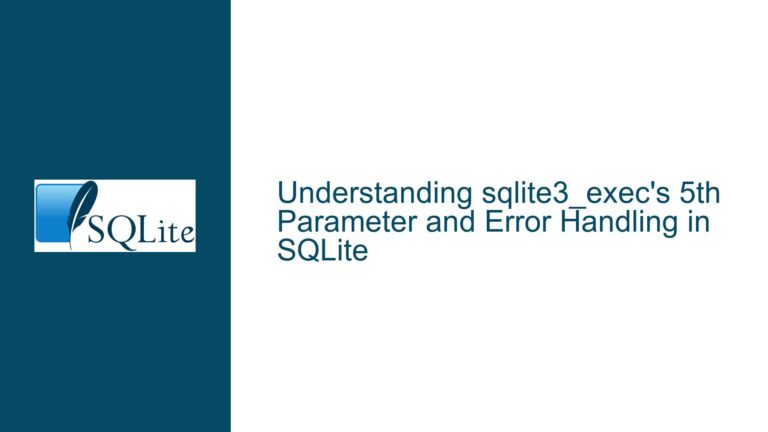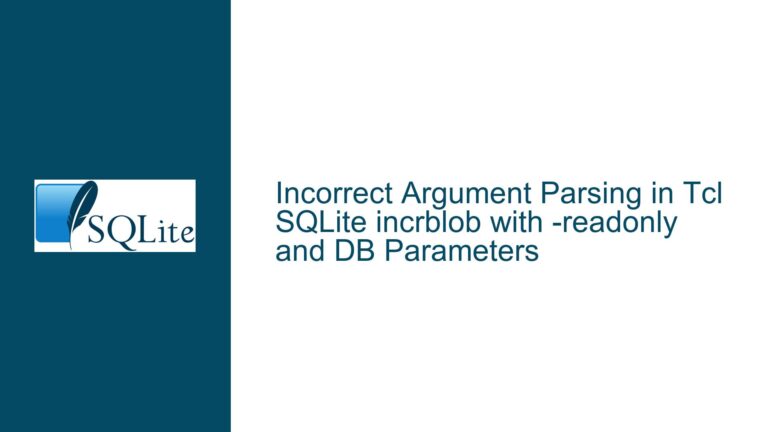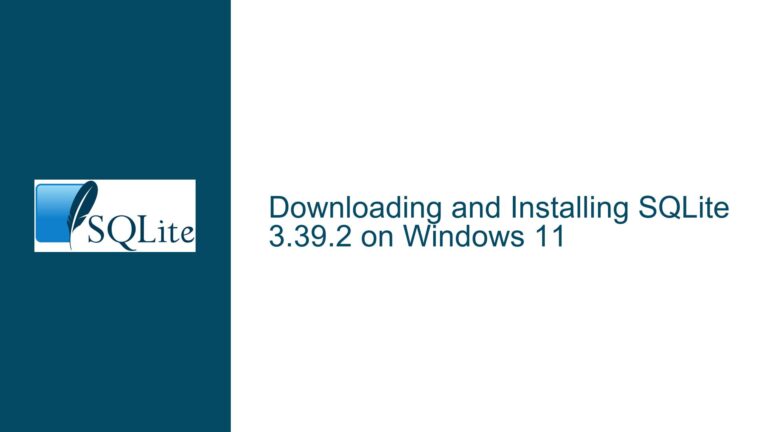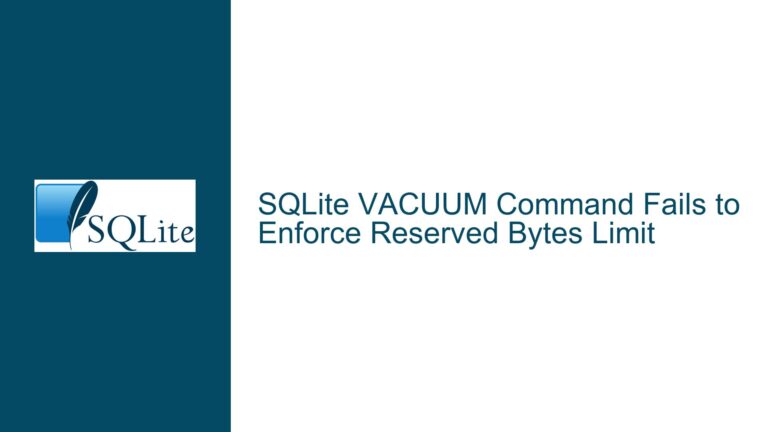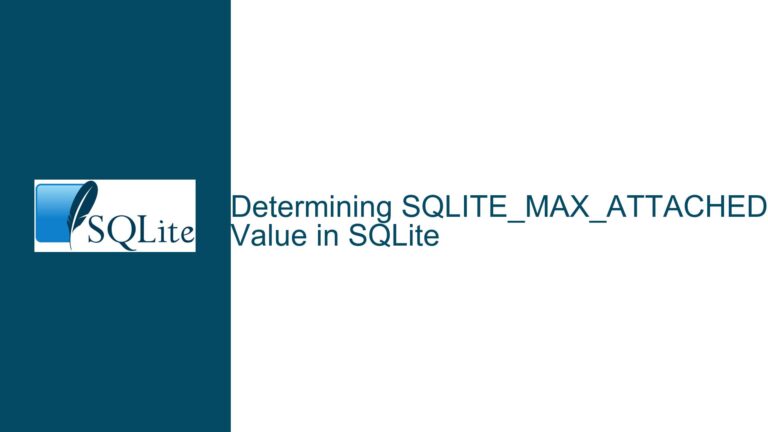Segmentation Fault in SQLite Online Backup API Due to Concurrent Backup Handles
Issue Overview: Concurrent Backup Handles Leading to Invalid Memory Access
The SQLite Online Backup API provides a mechanism for creating live backups of databases using the sqlite3_backup_init(), sqlite3_backup_step(), and sqlite3_backup_finish() functions. A segmentation fault (SEGV) occurs when multiple backup operations are initiated concurrently on the same source or destination database connections. This issue arises due to overlapping backup handles modifying shared internal database structures without proper synchronization or validation.
In the provided code example, three in-memory databases (d1, d2, d3) are opened. Three backup handles (b1, b2, b3) are created with interdependencies:
b1copies data fromd2tod3.b2copies data fromd3tod1.b3copies data fromd2tod1.
The crash occurs during the second sqlite3_backup_step(b2, 8421376) call. At this point, b1 has already been finished, and b3 was finished prematurely. The segmentation fault is caused by invalid memory access within the SQLite library when attempting to resume b2 after partial execution.
Key factors contributing to the crash include:
- Overlapping Backup Operations: Backup handles
b2andb3both targetd1as the destination. Concurrent writes to the same destination database connection violate internal assumptions about transaction state management. - Dependency Chain:
b2depends ond3, which is populated byb1. Ifb1is finished beforeb2completes,d3may enter an inconsistent state. - In-Memory Databases: The use of
:memory:databases exacerbates the issue, as these databases lack persistent storage and rely entirely on runtime memory structures.
The SQLite documentation explicitly warns against concurrent writes to the same database connection (see "Concurrent Usage of Database Handles" in the Backup API documentation). However, the API does not enforce this restriction programmatically, leading to undefined behavior such as segmentation faults when misused.
Possible Causes: Invalidated Backup Handles and Race Conditions
The segmentation fault stems from one or more backup handles accessing invalidated internal database structures. Below are the root causes:
1. Unsafe Concurrent Modifications to Destination Database
SQLite allows only a single writer to modify a database at any time. When multiple backup handles target the same destination database (d1 in this case), they compete for write access. The sqlite3_backup_step() function acquires a reserved lock on the destination database during its operation. If another backup handle attempts to modify the same destination concurrently, it may bypass lock acquisition checks, leading to memory corruption.
2. Premature Backup Handle Termination
The sqlite3_backup_finish(b3) call terminates b3 before completing its operation. This action releases resources associated with b3, including internal page caches and transaction state. However, b2 and b3 share the same destination database (d1). Terminating b3 may leave d1 in an unexpected state, invalidating assumptions made by b2 during its subsequent sqlite3_backup_step() call.
3. Dangling Pointers in Backup State Management
The SQLite backup subsystem maintains internal pointers to source and destination database connections. When a backup is finished via sqlite3_backup_finish(), these pointers are not always nullified. If another backup handle references the same database connection, subsequent operations may dereference stale pointers, causing a read from invalid memory addresses.
4. Race Conditions in Lock Hierarchy
SQLite employs a locking hierarchy to manage database access (UNLOCKED → SHARED → RESERVED → EXCLUSIVE). Backup operations transition locks dynamically as they copy data. Concurrent backups on interconnected databases (d1 ↔ d3 ↔ d2) can create circular lock dependencies, leading to deadlocks or inconsistent lock states. The segmentation fault manifests when the code attempts to proceed with an operation that assumes a specific lock state that no longer exists.
5. ASAN and Debug Builds Exposing Memory Errors
Address Sanitizer (ASAN) and debug builds with assertions enabled amplify visibility into memory management issues. In production builds, such errors might remain undetected temporarily but eventually cause data corruption or instability.
Troubleshooting Steps, Solutions & Fixes: Ensuring Atomic Backup Operations
1. Enforce Serialized Access to Backup Handles
Ensure that only one backup operation is active per destination database connection at any time. Modify the code to guarantee that sqlite3_backup_finish() is called on a handle before initiating another backup involving the same destination.
Example Fix:
sqlite3_backup *b1 = sqlite3_backup_init(d3, "main", d2, "main");
sqlite3_backup_step(b1, 8388608);
sqlite3_backup_finish(b1);
sqlite3_backup *b2 = sqlite3_backup_init(d1, "main", d3, "main");
sqlite3_backup_step(b2, 0);
// Ensure b2 completes before starting b3
sqlite3_backup_step(b2, 8421376);
sqlite3_backup_finish(b2);
sqlite3_backup *b3 = sqlite3_backup_init(d1, "main", d2, "main");
sqlite3_backup_step(b3, ...);
sqlite3_backup_finish(b3);
2. Validate Backup Handle State Before Proceeding
After calling sqlite3_backup_finish(), explicitly nullify the backup handle pointer to prevent accidental reuse. Always check the return value of sqlite3_backup_step() to detect errors.
Modified Code:
sqlite3_backup_step(b1, 8388608);
sqlite3_backup_finish(b1);
b1 = NULL; // Prevent accidental reuse
if (sqlite3_backup_step(b2, 0) == SQLITE_OK) {
// Proceed only if step succeeds
}
3. Use Database Mutexes for Concurrent Control
Wrap backup operations in critical sections using sqlite3_mutex_enter() and sqlite3_mutex_leave() if multiple threads access the same database connection. Note that SQLite’s threading mode must be configured appropriately (e.g., SQLITE_CONFIG_MULTITHREAD).
4. Avoid In-Memory Databases for Complex Backup Chains
In-memory databases (:memory:) are volatile and lack the durability guarantees of file-based databases. For operations involving multiple backups, use file-based databases to reduce the risk of pointer invalidation.
5. Upgrade to SQLite Versions with Patched Backup Logic
The SQLite development team addresses edge cases in the backup API over time. For example, versions after 3.37.0 include improvements in backup state management. Check the official changelog and apply updates.
6. Implement Application-Level Safeguards
- Dependency Graphs: Map backup operations as a directed acyclic graph (DAG) to detect cycles or conflicting accesses.
- Timeouts: Use
sqlite3_busy_timeout()to handle potential deadlocks gracefully. - Retry Logic: If
sqlite3_backup_step()returnsSQLITE_BUSY, retry the operation after a delay.
7. Leverage SQLITE_LOCKED_SHAREDCACHE Error Codes
When compiled with shared cache mode, SQLite returns SQLITE_LOCKED_SHAREDCACHE to indicate lock conflicts. Handle this error by aborting conflicting operations and retrying.
8. Audit Internal SQLite Structures
In debug builds, inspect internal structures like sqlite3_backup.pDest and sqlite3_backup.pSrc after each operation to ensure they reference valid database connections. Use breakpoints or logging to track state transitions.
By adhering to these practices, developers can mitigate segmentation faults in the SQLite Online Backup API while maintaining the integrity of backup operations.
